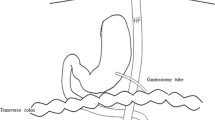Abstract
Background
In this study, we attempted to define the lower esophageal sphincter (LES) motor events associated with the occurrence of gastroesophageal reflux (GER) in neurologically impaired children in whom of GER disease recurred after laparoscopic Nissen fundoplication (LNF).
Methods
Of 45 neurologically impaired children who had previously undergone LNF, six children in whom recurrence of GER disease was documented by 24-h esophageal pH monitoring were studied. Concurrent esophageal manometry and pH monitoring were conducted for 1 h both before and after the administration of apple juice (10 ml/kg).
Results
A total of 89 reflux episodes were recorded in the course of the study. Of these, 51 episodes (57%) were associated with transient LES relaxation. In the remainder, reflux occurred across a contracted LES in 21 episodes (24%) and during absent basal LES tone in 15 episodes (17%). In four of six patients, transient LES relaxation was responsible for more than half of the reflux episodes.
Conclusion
Transient LES relaxation is the predominant mechanism of reflux in neurologically impaired children with recurrent GER after LNF.
Similar content being viewed by others
References
Hill LD, Ilves R, Stevenson JK, Pearson JM (1979) Reoperation for disruption and recurrence after Nissen fundoplication. Arch Surg 114: 542–548
Horgan S, Pellefrini CA (1997) Surgical treatment of gastroesophageal reflux disease. Surg Clin North Am 77: 1063–1082
Kawahara H, Dent J, Davidson GP (1997) Mechanisms responsible for gastroesophageal reflux in children. Gastroenterology 113: 399–408
Kawahara H, Dent J, Davidson G, Okada A (2001) Relationship between straining, transient lower esophageal sphincter relaxation, and gastroesophageal reflux in children. Am J Gastroenterol 96: 2019–2025
Kawahara H, Imura K, Nakajima K, Yagi M, Kamata S, Okada A (2000) Motor function of the esophagus and the lower esophageal sphincter in children who undergo laparoscopic Nissen fundoplication. J Pediatr Surg 35: 1666–1671
Kawahara H, Imura K, Yagi M, Yoneda A, Soh H, Tazuke Y, Okada A (1998) Mechanisms underlying the antireflux effect of Nissen fundoplication in children. J Pediatr Surg 33: 1618–1622
Kimber C, Kiely EM, Spitz L (1998) The failure rate of surgery for gastro-oesophageal reflux. J Pediatr Surg 33: 64–66
Mason RJ, DeMeester TR, Lund RJ, Peters JH, Crookes P, Ritter M, Gadenstatter M, Hagen JA (1997) Nissen fundoplication prevents shortening of the sphincter during gastric distension. Arch Surg 132: 719–726
Mittal RK, Holloway RH, Penagini R, Blackshaw LA, Dent J (1995) Transient lower esophageal sphincter relaxation. Gastroenterology 109: 601–610
Rosenberg S (1998) Experience with 220 consecutive laparoscopic Nissen fundoplications in infants and children. J Pediatr Surg 33: 274–278
Rydberg L, Ruth M, Lundell L (1997) Does oesophageal motor function improve with time after successful antireflux surgery? Results of a prospective, randomised clinical study. Gut 41: 82–86
Slim R, Forichon J, Boulez J, Mion F (2000) Laparoscopic fundoplication for gastroesophageal reflux: effects on esophageal motility. Surg Laparosc Endosc 10: 115–119
Soper NJ, Dunnegan D (1999) Anatomic fundoplication failure after laparoscopic antireflux surgery. Ann Surg 229: 669–677
Strombeck D, Turner W, Harrold D (1988) Eructation of gas through the gastroesophageal sphincter before and after gastric fundectomy in dogs. Am J Vet Res 49: 87–89
Vecchia LKD, Grosfeld JL, West KW, Rescorla FJ, Scherer LR, Engum SA (1997) Reoperation after Nissen fundoplication in children with gastroesophageal reflux. Ann Surg 226: 315–323
Author information
Authors and Affiliations
Additional information
Online publication: 8 February 2002
Rights and permissions
About this article
Cite this article
Kawahara, H., Nakajima, K., Yagi, M. et al. Mechanisms responsible for recurrent gastroesophageal reflux in neurologically impaired children who underwent laparoscopic Nissen fundoplication. Surg Endosc 16, 767–771 (2002). https://doi.org/10.1007/s00464-001-8228-1
Received:
Accepted:
Issue Date:
DOI: https://doi.org/10.1007/s00464-001-8228-1




